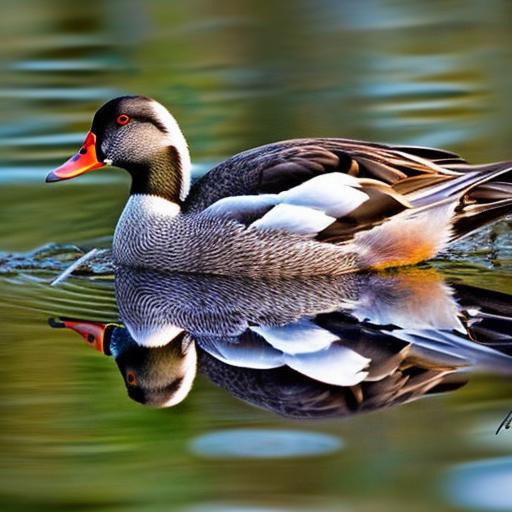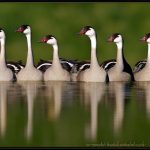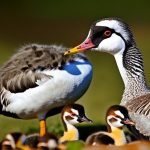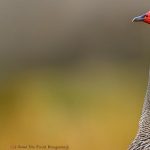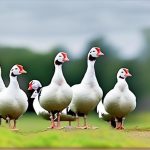Breeding between ducks and geese is a fascinating topic that has gained significant interest among poultry enthusiasts. Crossbreeding refers to the intentional mating of two different species or breeds to produce offspring with desired traits. In the case of ducks and geese, crossbreeding can result in unique hybrids that combine the characteristics of both species.
The interest in crossbreeding between ducks and geese stems from the desire to create new and unique breeds that possess desirable traits from both parent species. This can include traits such as increased meat production, improved egg-laying abilities, or enhanced disease resistance. Additionally, crossbreeding can also be done for aesthetic purposes, creating visually striking birds that are sought after by collectors and hobbyists.
Key Takeaways
- Breeding between ducks and geese is possible and can result in unique crossbred offspring.
- Understanding the biology of ducks and geese is important before attempting to crossbreed them.
- Crossbreeding can have both pros and cons, such as increased disease resistance but also potential infertility.
- Factors to consider before breeding include genetics, housing, and feeding requirements.
- Breeding techniques such as artificial insemination can be used to successfully crossbreed ducks and geese.
Understanding the Biology of Ducks and Geese
Ducks and geese are both members of the Anatidae family, but they have distinct differences in terms of size, behavior, and habitat. Ducks are generally smaller than geese and have a more varied diet, including both plant matter and small aquatic animals. Geese, on the other hand, are larger and primarily herbivorous, feeding on grasses and other vegetation.
In terms of reproduction and mating habits, ducks and geese also differ. Ducks are known for their complex courtship displays, with males often engaging in elaborate dances and vocalizations to attract females. Once a pair has formed, they will mate multiple times to ensure fertilization. Geese, on the other hand, form monogamous pairs that mate for life. They engage in less elaborate courtship displays but are known for their strong pair bonds.
The Pros and Cons of Crossbreeding Ducks and Geese
Crossbreeding between ducks and geese offers several advantages. One of the main benefits is the potential for hybrid vigor or heterosis. This refers to the increased fitness and performance of the hybrid offspring compared to their purebred parents. Hybrid ducks and geese may exhibit improved growth rates, disease resistance, and overall health.
Another advantage of crossbreeding is the creation of new and unique breeds that possess desirable traits from both parent species. This can be particularly appealing for poultry enthusiasts who are looking to create something different or improve upon existing breeds. Additionally, crossbreeding can also result in visually striking birds that are highly sought after by collectors and hobbyists.
However, there are also disadvantages to consider when it comes to crossbreeding ducks and geese. One potential drawback is the unpredictability of the offspring’s traits. While breeders may have a general idea of what traits they hope to achieve through crossbreeding, there is no guarantee that these traits will be expressed in the offspring. This can make it challenging to consistently produce desired characteristics.
Factors to Consider Before Breeding Ducks and Geese
Before embarking on a breeding program involving ducks and geese, there are several factors that need to be considered. First and foremost, space and environment requirements must be taken into account. Ducks and geese require adequate space to roam and access to water for swimming and foraging. The availability of suitable habitat is crucial for their overall health and well-being.
Breeding ducks and geese also requires a significant investment of time and finances. Breeding birds need to be properly cared for, which includes providing appropriate nutrition, veterinary care, and housing. Additionally, breeding programs often require specialized equipment such as incubators for hatching eggs. It is important to have a clear understanding of the time and financial commitment involved before starting a breeding program.
Legal considerations should also be taken into account when breeding ducks and geese. Some jurisdictions may have regulations or restrictions on the breeding or sale of certain species or hybrids. It is important to research and comply with any applicable laws or permits before engaging in crossbreeding activities.
Breeding Techniques for Ducks and Geese
There are several techniques that can be used for breeding ducks and geese, depending on the specific goals of the breeder. Natural breeding is the most common method, where males and females are allowed to mate naturally. This method allows for the expression of natural behaviors and instincts but may result in less control over the specific traits of the offspring.
Artificial insemination is another technique that can be used for breeding ducks and geese. This involves manually collecting semen from a male and inseminating a female with the collected semen. Artificial insemination allows for more control over the genetic makeup of the offspring and can be particularly useful for breeders looking to create specific hybrids or improve upon existing breeds.
Once eggs are laid, they can be incubated and hatched using specialized equipment. Incubation involves maintaining optimal temperature and humidity levels to ensure proper development of the embryos. Hatching can take several weeks, depending on the species and breed. Proper care must be taken during this process to ensure the health and survival of the hatchlings.
The Importance of Selecting the Right Breeding Stock
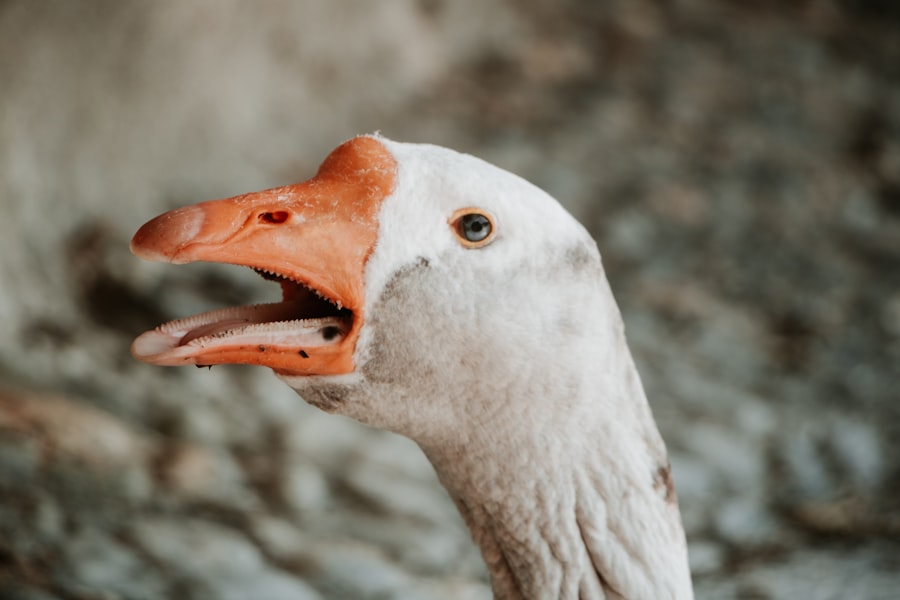
Selecting the right breeding stock is crucial for achieving desired traits in crossbred ducks and geese. When choosing breeding stock, it is important to look for individuals that possess desirable characteristics such as good health, strong body conformation, and desirable temperament. Additionally, breeders should also consider the genetic background of potential breeding birds to avoid any potential genetic problems or health issues.
It is also important to consider the specific goals of the breeding program when selecting breeding stock. For example, if the goal is to create a hybrid with increased meat production, then individuals with good growth rates and body conformation should be chosen. On the other hand, if the goal is to create a visually striking bird, then individuals with unique plumage or color patterns should be selected.
Common Challenges in Breeding Ducks and Geese
Breeding ducks and geese can come with its fair share of challenges. One common challenge is the potential for health issues. Ducks and geese are susceptible to various diseases and parasites, and breeders must take appropriate measures to prevent and treat these issues. Regular veterinary care, proper nutrition, and good hygiene practices are essential for maintaining the health of breeding birds.
Behavioral issues can also arise when breeding ducks and geese. Mating behaviors can sometimes be aggressive, and breeders must be prepared to manage any conflicts that may arise. Additionally, territorial behaviors can also be a challenge, especially if breeding birds are kept in close proximity to each other. Providing adequate space and resources can help minimize these behavioral issues.
Genetic problems can also occur when breeding ducks and geese. Inbreeding, or the mating of closely related individuals, can result in the expression of undesirable traits or health issues. Breeders must carefully manage their breeding programs to avoid any potential genetic problems by introducing new bloodlines or outcrossing with unrelated individuals.
Caring for Crossbred Ducks and Geese
Proper care is essential for the health and well-being of crossbred ducks and geese. Feeding and nutrition play a crucial role in their overall development and performance. A balanced diet that meets their nutritional needs should be provided, including a mix of grains, greens, and protein sources. Fresh water should also be available at all times.
Housing and environment requirements should also be considered when caring for crossbred ducks and geese. They require adequate space to roam and access to water for swimming and foraging. Housing should provide protection from predators, extreme weather conditions, and adequate ventilation to prevent respiratory issues.
Regular veterinary care is important for maintaining the health of crossbred ducks and geese. Routine check-ups, vaccinations, and parasite prevention measures should be implemented. Additionally, breeders should be knowledgeable about common health issues that can affect ducks and geese and be prepared to address any potential problems that may arise.
The Market for Crossbred Ducks and Geese
There is a growing demand for crossbred ducks and geese in the market. The unique traits and characteristics of these hybrids make them appealing to a wide range of customers. For example, crossbred ducks and geese that possess increased meat production or improved egg-laying abilities are sought after by commercial farmers and backyard poultry enthusiasts.
Additionally, there is also a market for visually striking crossbred ducks and geese. Collectors and hobbyists are often interested in acquiring birds with unique plumage or color patterns. These hybrids can be used for exhibition purposes or as pets.
Future of Breeding Between Ducks and Geese
The future of breeding between ducks and geese looks promising. As advancements in breeding techniques continue to evolve, breeders will have more tools at their disposal to create new and unique hybrids. Additionally, the potential impact on the poultry industry cannot be overlooked. Crossbreeding between ducks and geese has the potential to create new breeds that possess desirable traits for commercial production, such as increased meat yield or improved disease resistance.
In conclusion, breeding between ducks and geese offers a world of possibilities for poultry enthusiasts. While there are challenges to overcome, the potential rewards in terms of creating new breeds with desirable traits make it an exciting endeavor. With careful planning, proper care, and a clear understanding of the goals of the breeding program, breeders can contribute to the advancement of the poultry industry and create unique and valuable hybrids.
If you’re interested in learning more about breeding between ducks and geese, you might find this article on Poultry Wizard quite informative. It discusses the importance of providing a suitable environment for your poultry, such as the Producers Pride Sentinel Chicken Coop. This coop is designed to offer a safe and comfortable space for your birds to breed and lay eggs. Additionally, the article also touches upon the significance of the floor of the chicken coop, which plays a crucial role in maintaining cleanliness and preventing diseases. To ensure the health and well-being of your ducks and geese, it’s essential to provide them with proper nutrition. Poultry Wizard’s article on what to feed ducks offers valuable insights into their dietary requirements. So, if you’re considering breeding these beautiful waterfowl, be sure to check out these helpful resources: Producers Pride Sentinel Chicken Coop, floor of the chicken coop, and what should you feed ducks.
FAQs
What is breeding between ducks and geese?
Breeding between ducks and geese refers to the process of mating between a male duck and a female goose or vice versa, resulting in offspring that are a hybrid of the two species.
Is breeding between ducks and geese common?
Breeding between ducks and geese is rare in the wild, but it can occur in captivity or in areas where the two species coexist.
What are the characteristics of the offspring produced by breeding between ducks and geese?
The offspring produced by breeding between ducks and geese are typically sterile and have a mix of physical characteristics from both species, such as a duck-like bill and webbed feet, and a goose-like body shape and size.
Can the offspring of breeding between ducks and geese reproduce?
No, the offspring of breeding between ducks and geese are typically sterile and cannot reproduce.
What are the potential risks of breeding between ducks and geese?
Breeding between ducks and geese can lead to genetic abnormalities and health problems in the offspring, as well as potential negative impacts on the populations of both species if the hybrids are released into the wild. It is generally not recommended to intentionally breed ducks and geese together.
Meet Walter, the feathered-friend fanatic of Florida! Nestled in the sunshine state, Walter struts through life with his feathered companions, clucking his way to happiness. With a coop that’s fancier than a five-star hotel, he’s the Don Juan of the chicken world. When he’s not teaching his hens to do the cha-cha, you’ll find him in a heated debate with his prized rooster, Sir Clucks-a-Lot. Walter’s poultry passion is no yolk; he’s the sunny-side-up guy you never knew you needed in your flock of friends!

